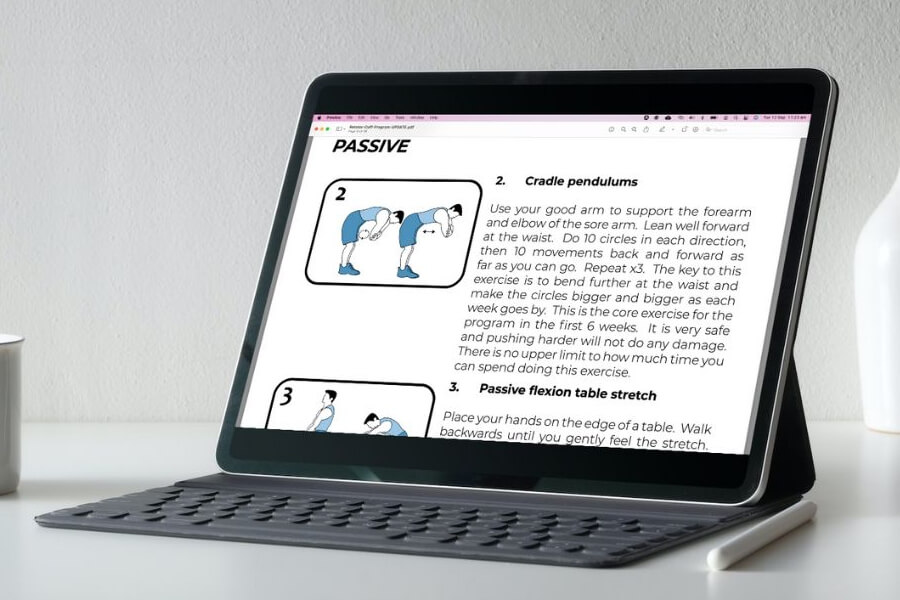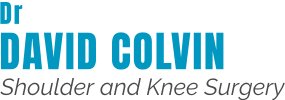- Dr David Colvin
Seven tips to make a faster recovery from rotator cuff repair surgery
Recovering from rotator cuff repair surgery is a team effort. There’s the surgery – which is half of the journey – and there is you. Your dedication to following the rehab steps and exercises is just as important as the procedure itself.
“In some ways, the surgery to have your rotator cuff tear repaired is the easy bit. The hard yards come with the post surgery rehabilitation”
Dr David Colvin, Shoulder Surgeon Perth
The single biggest complication that prolongs rotator cuff repair recovery is postoperative frozen shoulder. That’s why it is important to do your exercises religiously (tip #3). They are designed to be safe and protect the repair.
“People tend to underdo their rehabilitation for two reasons. The first one is because they are in pain and that’s why controlling your pain is important. The second reason for underdoing the rehabilitation is fear of re-tearing the repair. Although there is a risk of re-tearing, the exercises are designed to protect the repair and the exercises, if done correctly, will not cause the repair to fail.”
Dr David Colvin, Shoulder Surgeon Perth
Rotator cuff repairs fail for a multitude of reasons. Common reasons include a large tear, a highly retracted tendon, or a poor-quality tendon. External factors, like smoking and diabetes, also play a significant role in the tendon’s healing ability. If the surgeon is concerned about the repair, then we often advise a more cautious rehabilitation program.
For most patients, fear of doing damage leads to inadequate rehabilitation and greatly increases the risk of postoperative frozen shoulder.
“On the whole, I would see nine patients who have done too little for every one person who has done too much.”
Dr David Colvin, Shoulder Surgeon Perth
Now, as you journey through recovery, having actionable tips can make all the difference. Below are seven tips for a faster recovery from rotator cuff repair surgery.
#1 Control your pain
High pain levels will stop you from doing the necessary exercises. I believe it is important to have your pain under control before you leave the hospital. Make sure that on discharge you have a clear idea of the pain relief schedule. Successful pain control is achieved by taking simple painkillers (Paracetamol and anti-inflammatories) regularly and adding in the stronger narcotic painkillers as required. You can read more in my postoperative pain relief advice article.
#2 Reduce swelling
Swelling is part of the inflammatory response induced by the trauma of surgery. It causes joint stiffness and the muscles stop working. The best way to help control shoulder swelling is with ice. One of the simplest ways to get the ice to conform to the shape of your shoulder is to use a large bag of frozen peas. Do not apply ice directly to the skin. You can do three or four fifteen-minute sessions per day and it will assist greatly with pain relief as well.
#3 Do your exercises religiously

Early on, when the shoulder is painful, lots of small exercise sessions is the best approach. Five minutes every hour will add up over the course of the day. As the pain levels improve you will do fewer sessions but they will be longer.
Frozen shoulder is the complication we most want to avoid. This condition can develop very early in the postoperative period. Some people do everything right and still get a frozen shoulder. However, the majority of patients suffering a frozen shoulder simply have not done enough in the early stages. I tell people that we can always build strength in the shoulder at a later date, but the range of motion exercises need to start immediately. We cannot kick that can down the road. Once the shoulder gets stiff the pain levels increase and it is harder to do the stretches and you enter into a vicious downwards spiral.
It is possible of course to do too much. Make sure you understand the difference between active and passive exercises. All exercise in the early weeks is passive.
#4 Get some sleep
More than any other operation, shoulder surgery interrupts your sleep. Poor
sleep leads to poor pain tolerance. Getting good sleep after shoulder surgery is easier said than done.
The first step is getting good pain relief and that means regular analgesia.
Do whatever it takes to get comfortable in bed. Use pillows to prop yourself into a comfortable position. Some people find sleeping in a recliner chair is more comfortable. Remember that you must wear your sling during your sleep. If you are a restless sleeper try wearing a shirt over the top of your sling.
Do not take sleeping tablets if you are taking narcotic painkillers; that is a dangerous combination. Once you are off the stronger painkillers a short course of sleeping tablets may be appropriate but always with a definite end date in mind.
#5 Know your sling
You will be required to wear a sling for four to six weeks. Often the sling includes an abduction pillow. It is not safe to remove the abduction pillow unless that has been advised by your shoulder surgeon. It serves an important function to take tension off the rotator cuff repair.
Types of sling
Two types of slings are used following rotator cuff repair surgery.
The first sling is called a simple broad arm sling. This allows the arm to rest against your body. This sling is used for small or stable tears. It is usually only required for four weeks.
The second type of sling is called an abduction sling. It has a pillow underneath the arm to hold it away from the body. This takes some tension off the repaired tendons. We use this type of sling for larger tears or where the tendon has been repaired with some tension. It is usually worn for six weeks.
When to wear your sling?
The sling should be worn at all times except when doing your exercises. However, if you are sitting down, you can take the sling off and use pillows to hold the arm in a similar position. This will allow you to bend and straighten the elbow and relieve muscle spasm.
Showering
You will be provided with a collar and cuff sling to wear in the shower. This sling can get wet and is removed after the shower.
Be cautious when getting into and out of the collar and cuff sling. When changing the sling over, many people inadvertently lift their arm using their own muscles (active abduction) and this puts stress on the repair.
How to take your sling off
Sit with your arm supported horizontally on a pillow. Remove the waist strap and then the neck strap. Keep the arm still while removing the sling. Slide it off the elbow. Support the arm at the elbow when not wearing a sling.
How to put your sling on
Sit with your arm supported on a pillow. Using your good hand, support the operated arm at the elbow and place it into the open sling. Slide your elbow back into the corner of the sling and the hand is placed thumb up through the loop. Replace the neck strap first and then the waist strap. The neck strap should be tensioned so that your arm is horizontal across the body, elbow bent at ninety degrees. When correctly positioned, you should feel that the entire forearm and elbow are well supported by the sling. Position the pillow at the side or front as comfortable.
Dressing
Put a sleeve over the sore arm first, then pull the shirt over your head. Then the good arm goes in its sleeve. Reverse this procedure to remove a shirt.
#6 Get in the pool
As soon as your surgeon clears you to do pool based exercise you should do so. It is a great way to get the shoulder moving in a stress reduced environment and helps relieve pain. Your physiotherapist can instruct you on pool based exercises. Most physiotherapists do supervised hydrotherapy sessions initially.
#7 Get a routine going
Just like an athlete in training, postoperative rehabilitation works best if you have a training schedule. Try to exercise at regular times and even set an alarm to remind you.
Follow the athlete’s example when it comes to eating and drinking as well. Keeping well hydrated. A diet with a high fibre content will stop you from getting constipated from the painkillers. If you are eating a healthy diet there is very little indication to take supplements but a simple multivitamin will cover a lot of bases.
